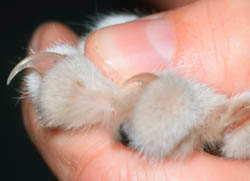If you live with cats, you will notice that it is normal for them to scratch. It serves to groom the front nails, while leaving markers of their presence behind on surfaces. They also scratch to stretch their muscles. To protect your furniture, you can train them to scratch on appropriate surfaces, and trim their nails yourselves regularly. People are constantly asking me to demonstrate just how to do this. So, I thought it a perfect blog idea.
The tools:
Proper feline nail trimmers are key to prevent splintering of the nails. There are 2 main types that I recommend. Guillotine trimmers (green, pictured) are the most common type used, and are readily available in pet stores. They cut vertically, and are shown in the pictures here. There is another type (blue handled) that cuts horizontally. Both involve cutting at the same landmarks, and personal preference will help you decide what works best for you.
Practice:
If possible, start trimming during kittenhoood, so they become comfortable with it early on. Still, you can get any age cat used to it with perseverance. and practice, in a calm environment. Provide positive reinforcement consistently. As with any skill, proficiency will take time.
Pictures are worth a thousand words (or at least I hope so):

Proper restraint is key to making the procedure as smooth, and quick, as possible.
The cat here is sitting on the person’s lap. Also, you may find it easier to place your cat on a table and lean over her the same way. Drape your forearms with mild pressure on the cat, stabilizing her and somewhat containing her . One arm is over each end of the cat, allowing forefoot and hindfoot access when necessary.
I usually try to start at the front feet, but it really varies with preference.
If you are right handed, hold the trimmer in your right hand. If using a guillotine trimmer, the blade should face you and not the cat.

Cats have retractile claws, and you can expose the nail by gently squeezing the toe between your thumb and forefinger. Most cats have light colored nails, making it easy to see the blood vessels and nerves that you want to avoid cutting. Some have mixed dark and light nails, so learning on the lighter nails helps you judge where not to cut on the dark nails.
The blood vessel is referred to as the “quick”.

You want to line up your blade just in front of the quick as shown. Then press the handle, which allows the blade to slice up and through the nail.
If you are using the horizontal type cutters, you would line up in the same place, but the cut will be left to right
The sharper the trimmer, the smoother the end of nail will be.
Remember that there is an extra claw, similar to a thumb, on the forefeet, closer to the body. It is known as the dewclaw. If left untrimmed, it can overgrow and curl into the pad, causing pain and infection, necessitating a call to the veterinarian. A small number of cats also have extra claws in between the others. These cats are known as polydactyl, and there can be any number of extra toes found.
If you do cut too close and cause bleeding, it is a good idea to have styptic powder purchased and ready nearby. Some pressure on the area typically is all that is needed, with the powder, for several seconds or so.
Hope you found this helpful.
Dr. Dawn
Please share and subscribe here












